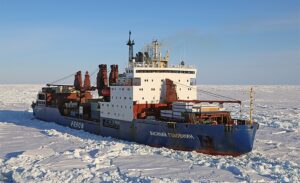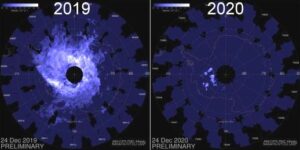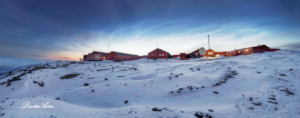 The QSL of Y83ANT, (sept. 13,1983) shows the GDR station “near Novolazarevskaya” at 71°S, 12°E. There is no mention of a name of this Base on the QSL, just a generic “GDR station near Novolazarevskaya.
The QSL of Y83ANT, (sept. 13,1983) shows the GDR station “near Novolazarevskaya” at 71°S, 12°E. There is no mention of a name of this Base on the QSL, just a generic “GDR station near Novolazarevskaya.
A question arose: If Georg Forster Station was located at 70°46’S-11°51’E, is this old one, the same Base?
We have to thanks 2 Antarctic veterans, several time operating from this Antarctic site, who did help WAP to write a true story of this East Germany (GDR) laboratory, established near the Russian Novolararevskaya Sation: Ing. Andreas Mueller DL3LRM, and Dr. Volker Strecke DL8JDX.
Andreas said:
«Historically, the team from East Germany has been a part of the Russian Novo Station since the late 1970s, but had their own base about a kilometer away from the main building. In 1987, this base (a set of containers and an antenna areal) was named “George Forster” in order to become the first official research station of East Germany, as part of their efforts to be part of the Antarctic Treaty (which demands that a Country has to run a permanent all year base in Antarctica). So this is the reason why the QSL only states “near Novolazarevskaya”, since in 1983, as “George Forster” was not established yet. Had the privilege to visit that site and the plague twice, and also to met some of its residences».
Volker, another old time Antarctic veteran and operator of Georg Forster Station (WAP DDR-Ø1) sent us a complete explanation that clarifies the entire story on the GDR activity in Antarctica.
Volker wrote:
«The former East Germany (German Democratic Republic GDR) acceded to the Antarctic Treaty System (ATS), see http://www.ats.aq on November 19, 1974, initially as non-consultative member. The GDR built this “Container station” in 1976 in the Schirmacher Oasis near the Russian Station Novolazarevskaya (WAP RUS-Ø9). It was called GDR Base Laboratory near Novoalazarevskaya. The only one HAM Radio activity from that Base Laboratory, between 1976 and 1987 was Y83ANT in 1983.
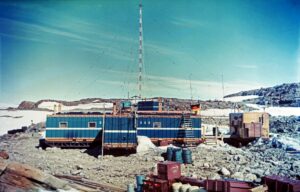 Picture aside, shows an old view, shortly after the completion of the GDR Base Laboratory near Novolazarevskaya in 1976 (Photo: Hartwig Gernandt, AWI Bremerhaven).
Picture aside, shows an old view, shortly after the completion of the GDR Base Laboratory near Novolazarevskaya in 1976 (Photo: Hartwig Gernandt, AWI Bremerhaven).
The GDR research activities included scientific works on ionospherics, magnetics, geology, chemistry and biology, were supported by the Russian colleagues from Novolazarevskaya and by the Indian colleagues from Dakshin Gangotri (WAP IND-Ø1) and Maitri (WAP IND-Ø3).
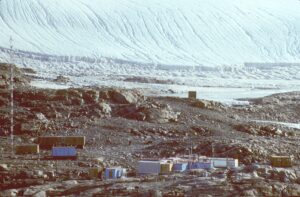 After ratification of the Treaty, the GDR received ATS consultative status on October 5, 1987. This was associated with an own research station in Antarctica. So the existing base laboratory was officially named GDR Antarctic Research Station Georg Forster (WAP DDR-Ø1) at Oct. 25, 1987.
After ratification of the Treaty, the GDR received ATS consultative status on October 5, 1987. This was associated with an own research station in Antarctica. So the existing base laboratory was officially named GDR Antarctic Research Station Georg Forster (WAP DDR-Ø1) at Oct. 25, 1987.
In the summer season 1987-1988 at Georg Forster, a completely new radio station was built. Georg Forster did get the marine Call Y3ZA and the land-based Call Y3G. The radio system was a very powerful and reliable: KSS-1300 with 1 KW, able to operate in CW, SSB and SITOR Telex, several EKD-500 receivers, an extremely good working 2x85m V-Beam, a corner reflector antenna, a diversity antenna, a vertical antenna and several wire antennas».
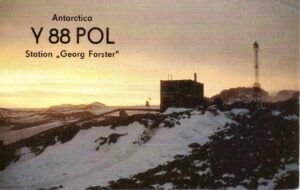 HAM Radio activities from Georg Forster were:
HAM Radio activities from Georg Forster were:
1988-1989 Y88POL (op: DL8JDX)
1989-1991 Y90ANT (op: DK1BT)
1990-1992 Y88POL (op: DL8JDX)

The Georg Forster Base had 5 overwintering teams:
- Antarctic Expedition (AE) 1987-1989 with 8 members (including Volker, DL8JDX, as electronic engineer)
- AE 1988-1990 with 8 members
- AE 1989-1991 with 8 members
- AE 1990-1992 with 4 members (including Volker, DL8JDX, as electronic engineer, Radio officer and Post officer)
- AE 1991-1993 with 1 member
After the German reunification at Oct. 3, 1990 it was decided later that the further German Antarctic research activities would have been focused at Neumayer II Base and its surroundings. So in the years 1994, 1995 and 1996 the entire Georg Forster Station had been dismantled and disposed of.
A commemorative plaque was left at this place. The former Georg Forster base was included into the ATS list of historic sites in Antarctica with No. 87.
List of all Antarctic historic sites: https://documents.ats.aq/recatt/att596_e.pdf
Volker concludes his report saying: «Andreas, DL3LRM is completely right with his comments based on his experience. As he was op. at DPØGVN in Neumaye III and operator at DP0POL/MM on the icebreaker Polarstern, He is the real expert and one of the few persons who were in the Antarctic and in the Arctic in the same year (2020)».
Thanks to Volker, DL8JDX, (WAP Ambassador) and operator in several Antarctic Overwintering Expeditions:
1988-1989 Y88POL Georg Forster
1990-1992 Y88POL Georg Forster
1992-1994 DPØGVN Neumayer II
And thanks to Andreas DL3LRM another great operator for years in Antarctica

Photo 1 aside: Georg Forster base in March 1991 (Photo: Volker Strecke, DL8JDX)
Photo 2 below : Georg Forster Historic Site Plaque in December 2018 (Photo: Andreas Mueller, DL3LRM)
 Photo 3 here at the right: Georg Forster First Day cover with special stamp for the opening of the postal office at May 1, 1988 (Volker Strecke)
Photo 3 here at the right: Georg Forster First Day cover with special stamp for the opening of the postal office at May 1, 1988 (Volker Strecke)
Documents say: The site of the former Georg Forster station is marked by a bronze plaque. It has been designated a Historic Site or Monument (HSM 87), following a proposal by  Germany to the Antarctic Treaty Consultative Meeting.
Germany to the Antarctic Treaty Consultative Meeting.
At the light of this new evidences, a new WAP reference number WAP DDR-Ø2 has been issued to:
GDR Base Laboratory near Novolazarevskaya,
71° South, 12° East
Location: Schirmacher Oasis
Callsign Y83ANT
Year of activity 1983
WAP DDR-Ø1 (from Oct 5, 1987, till Oct. 5, 1990) remains issued for Y88POL and Y90ANT.
The applicants who have submitted Y83ANT as DDR-Ø1, will be automatically credited DDR-Ø2 to it, and they eventually have to submit one of the two calls Y88POL or Y90ANT for DDR-Ø1.
Once again, thanks to DL8JDX and DL3LRM for their evaluable help and support.


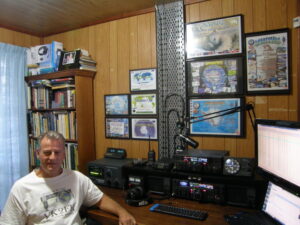

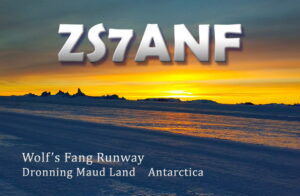 Wolf’s Fang Runway (WAP MNB-12)
Wolf’s Fang Runway (WAP MNB-12)
 The QSL of Y83ANT, (sept. 13,1983) shows the GDR station “near Novolazarevskaya” at 71°S, 12°E. There is no mention of a name of this Base on the QSL, just a generic “GDR station near Novolazarevskaya.
The QSL of Y83ANT, (sept. 13,1983) shows the GDR station “near Novolazarevskaya” at 71°S, 12°E. There is no mention of a name of this Base on the QSL, just a generic “GDR station near Novolazarevskaya.
 After ratification of the Treaty, the GDR received ATS consultative status on October 5, 1987. This was associated with an own research station in Antarctica. So the existing base laboratory was officially named GDR Antarctic Research Station Georg Forster (WAP DDR-Ø1) at Oct. 25, 1987.
After ratification of the Treaty, the GDR received ATS consultative status on October 5, 1987. This was associated with an own research station in Antarctica. So the existing base laboratory was officially named GDR Antarctic Research Station Georg Forster (WAP DDR-Ø1) at Oct. 25, 1987.


 Germany to the Antarctic Treaty Consultative Meeting.
Germany to the Antarctic Treaty Consultative Meeting. KM1CC has been “on the air” to commemorate the 118th Anniversary of Marconi sending the first transatlantic message from the USA to Europe (UK) on January 18, 1903. The message was sent from Marconi’s South Wellfleet, MA USA Wireless Station and received at his Poldhu Station, in UK.
KM1CC has been “on the air” to commemorate the 118th Anniversary of Marconi sending the first transatlantic message from the USA to Europe (UK) on January 18, 1903. The message was sent from Marconi’s South Wellfleet, MA USA Wireless Station and received at his Poldhu Station, in UK.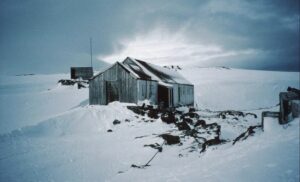 The British established Base W on Detaille Island in 1956, intending to use it to launch dog-sledding expeditions across the ice to the Antarctic Peninsula, and conduct geologic and meteorologic research.
The British established Base W on Detaille Island in 1956, intending to use it to launch dog-sledding expeditions across the ice to the Antarctic Peninsula, and conduct geologic and meteorologic research.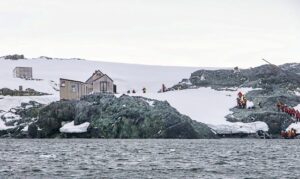
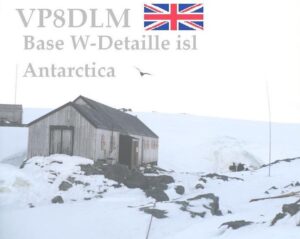 The British Antarctic Survey (BAS) is the national operation running in the frozen desert and is part of the Natural Environmental Research Council. With over 400 staff, BAS takes an active role in Antarctic affairs, operating five research stations, two ships and five aircraft in both polar regions, as well as addressing key global and regional issues. This involves joint research projects with over 40 UK universities and more than 120 national and international collaborations since a small expedition established a permanently occupied base on the continent during World War 2.
The British Antarctic Survey (BAS) is the national operation running in the frozen desert and is part of the Natural Environmental Research Council. With over 400 staff, BAS takes an active role in Antarctic affairs, operating five research stations, two ships and five aircraft in both polar regions, as well as addressing key global and regional issues. This involves joint research projects with over 40 UK universities and more than 120 national and international collaborations since a small expedition established a permanently occupied base on the continent during World War 2. At the end of last november a nontraditional ceremony was held at the Lyttelton Port in Christchurch, New Zealand, to welcome the docking of Chinese research Icebreaker Xuelong 2, or (Snow Dragon 2), which carries members of the 37th Chinese Antarctic scientific expedition, arrived in Christchurch after a 17-day voyage.
At the end of last november a nontraditional ceremony was held at the Lyttelton Port in Christchurch, New Zealand, to welcome the docking of Chinese research Icebreaker Xuelong 2, or (Snow Dragon 2), which carries members of the 37th Chinese Antarctic scientific expedition, arrived in Christchurch after a 17-day voyage.

 WAP-WACA
WAP-WACA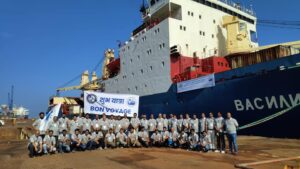 0 ISEA (Indian Scientific Expedition to Antarctica) sailed off from Mormugao Port with 43 Indian members on board.
0 ISEA (Indian Scientific Expedition to Antarctica) sailed off from Mormugao Port with 43 Indian members on board. VE1HQ, Mr. Sheldon Roy Donaldson from Pubnico, NS, Canada, is a keen DXer and Antarctic chaser. He has just received his WAP-WADA Honor Roll plate and certificate on Jan 8th 2021.
VE1HQ, Mr. Sheldon Roy Donaldson from Pubnico, NS, Canada, is a keen DXer and Antarctic chaser. He has just received his WAP-WADA Honor Roll plate and certificate on Jan 8th 2021.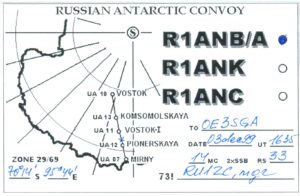 Often, studies were carried out on the scientific traverse as for example the 1978–1984 Mirny–Komsomolskaya–Ridge B, Denman Glacier and Dome Concordia, or the 1999-2000 Mirny-Vostok traverse with intermediate stops at Pionerskaya (WAP RUS-1Ø), and Konsomolskaya (WAP RUS-Ø5) as well as the so called Vostok I (WAP RUS-14) and more specifically the stopping sites on the way to the North and South of Vostok I Base as reported on several QSL cards.
Often, studies were carried out on the scientific traverse as for example the 1978–1984 Mirny–Komsomolskaya–Ridge B, Denman Glacier and Dome Concordia, or the 1999-2000 Mirny-Vostok traverse with intermediate stops at Pionerskaya (WAP RUS-1Ø), and Konsomolskaya (WAP RUS-Ø5) as well as the so called Vostok I (WAP RUS-14) and more specifically the stopping sites on the way to the North and South of Vostok I Base as reported on several QSL cards.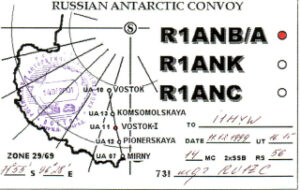 So for example: Ham radio did operate from there so for example R1ANB/A at 70° 14’ South-95° 44’ East (3 dec.1999), 71° 55’ Sout-96° 28’ East (11.dec.1999), 75° 12’ South-97°02’ East (14 dec.1999), R1ANC did operate at 69° 24’ South-95° 11’ East (27 dec.1999), where most of the ground Radio Echo Soundings inspections have been done.
So for example: Ham radio did operate from there so for example R1ANB/A at 70° 14’ South-95° 44’ East (3 dec.1999), 71° 55’ Sout-96° 28’ East (11.dec.1999), 75° 12’ South-97°02’ East (14 dec.1999), R1ANC did operate at 69° 24’ South-95° 11’ East (27 dec.1999), where most of the ground Radio Echo Soundings inspections have been done.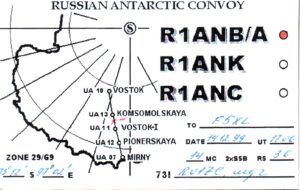 From 25 dec.2002 through 15 jan.2003, on the 48th Russian Antarctic Expedition (RAE) R1ANC/P did operate at 78°18’ South, 106°32’ East as well reported by the operator (UA1PAC Alex Kuz’menko) itself:
From 25 dec.2002 through 15 jan.2003, on the 48th Russian Antarctic Expedition (RAE) R1ANC/P did operate at 78°18’ South, 106°32’ East as well reported by the operator (UA1PAC Alex Kuz’menko) itself: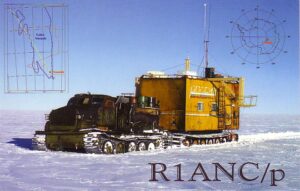 Antarctica.
Antarctica. 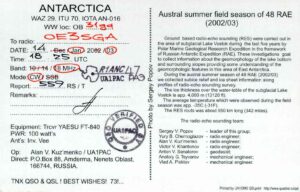 During the austral summer season of 48 RAE (2002/03) we collected sub-ice relief and ice sheet information along profiles of radio-echo sounding survey. The ice thickness over the water-table of the subglacial Lake Vostok is app. 4,000 m (13120 ft). The average temperature which’ were observed during the field season was app. -35C (-31F). The RES routs was about 550 km long (342 miles).
During the austral summer season of 48 RAE (2002/03) we collected sub-ice relief and ice sheet information along profiles of radio-echo sounding survey. The ice thickness over the water-table of the subglacial Lake Vostok is app. 4,000 m (13120 ft). The average temperature which’ were observed during the field season was app. -35C (-31F). The RES routs was about 550 km long (342 miles).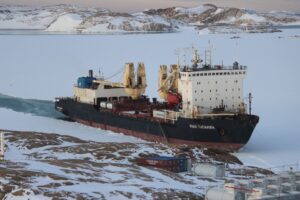 The chartered ice-class vessel M/V Vasiliy Golovnin will make this journey and will reach Antarctica in 30 days.
The chartered ice-class vessel M/V Vasiliy Golovnin will make this journey and will reach Antarctica in 30 days.